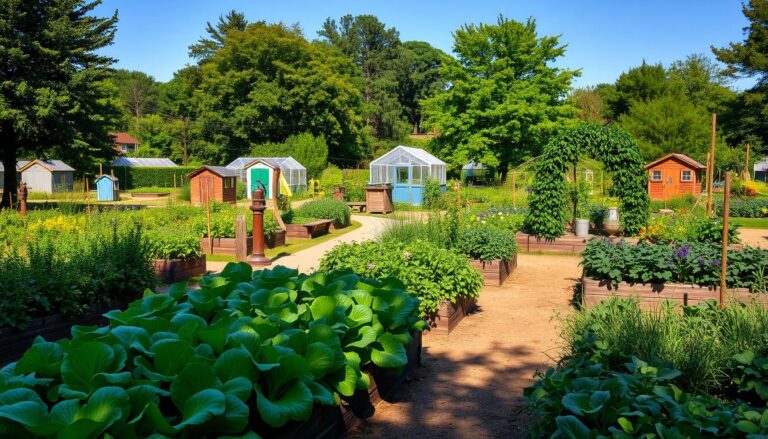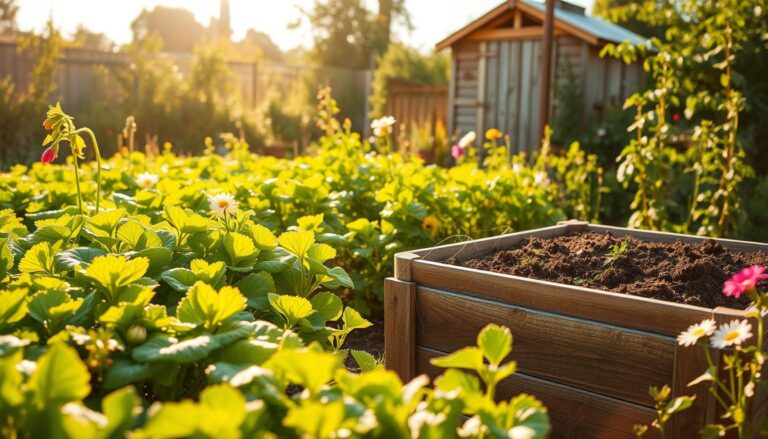Growing a thriving organic garden is more than just caring for your plants. It also means protecting them from pests. Many gardeners want to keep pests away without using harsh chemicals.
Keeping your garden balanced is key. This means using natural pest control methods that are good for the environment. This way, you protect your plants and help the environment too.
Finding the right balance is the challenge. You want to keep pests away but also keep your garden healthy. With the right strategies, you can have a great harvest while staying true to your values.
Understanding Common Garden Pests in Organic Gardens
Keeping an organic garden means knowing the pests that can harm it. Organic gardening uses natural ways to fight pests. It’s key to know how to handle pest problems.
Identifying Destructive Insects vs. Beneficial Ones
Not all insects are bad for your garden. Many are good and help keep the garden balanced. Beneficial insects like ladybugs eat pests that harm plants. It’s important to tell the good ones from the bad.
Visual Identification Guide for Common Garden Pests
A visual guide helps spot common pests. For example, aphids are small and soft, found in groups on plants.
Signs of Pest Damage on Plants
Look for signs like holes in leaves or white powdery patches. These show pests are present. Catching pests early is crucial for non-toxic pest management.
The Lifecycle of Common Garden Pests
Knowing a pest’s life cycle helps manage them better. Pests like aphids and caterpillars have unique life stages. This knowledge guides your control plans.
Seasonal Pest Patterns in the United States
Pest activity changes with the seasons. Aphids are common in spring and early summer. Knowing these patterns helps plan eco-friendly pest solutions.
Understanding Pest Reproduction Cycles
Pests breed fast, with some having many generations in a season. Knowing how they reproduce helps time your pest control.
As
“The best way to manage pests is to understand their life cycle and behavior, allowing for targeted and effective control methods.”
This method helps control pests and keeps the garden balanced.
Preventive Measures for Organic Gardening Pests
Managing pests is key to a successful organic garden. By taking steps early, gardeners can keep pests away and maintain a healthy garden.
Crop Rotation Strategies
Crop rotation is a basic method in organic gardening. It means changing what you grow in a spot to keep the soil rich and pests down. This method breaks pests’ life cycles and lowers disease risk.
Planning a 3-Year Rotation Schedule
Creating a 3-year rotation plan is smart. It groups crops by family and rotates them. This keeps the soil fertile and pest pressure low.
Plant Family Groupings for Effective Rotation
Grouping plants by family, like Brassicas or Solanaceae, helps in planning. It avoids soil nutrient loss and pest buildup.
| Year | Crop Family | Example Crops |
|---|---|---|
| 1 | Brassicas | Broccoli, Cauliflower |
| 2 | Solanaceae | Tomatoes, Peppers |
| 3 | Legumes | Beans, Peas |
Companion Planting for Pest Deterrence
Companion planting is growing different plants together. It improves growth and health, or repels pests.
Best Companion Plants for Vegetable Gardens
Marigolds fight nematodes, while basil keeps aphids away. These plants help vegetables stay healthy.
Aromatic Herbs That Repel Common Pests
Herbs like mint, rosemary, and sage keep pests away. Adding them to your garden can deter pests.
Timing Your Plantings to Avoid Pest Cycles
Knowing pest life cycles helps plan plantings. This avoids peak pest times and reduces infestations.
Early Season vs. Late Season Planting Benefits
Planting early lets crops grow before pests arrive. Late planting misses peak pest times.
Using Row Covers During Peak Pest Periods
Row covers act as a barrier against pests. They protect crops during peak pest times.
Natural Repellents and Organic Deterrents
Natural repellents are a great choice for gardeners who want to protect their crops without harming the environment. These organic deterrents not only keep pests away but also help create a healthier ecosystem.
Essential Oil Sprays and Their Applications
Essential oils can be very effective natural repellents. Neem oil, for example, is known for keeping many pests away.
DIY Neem Oil Formulations
To create a neem oil spray, combine 2 tablespoons of neem oil with 1 liter of water. A bit of mild dish soap can help the spray stick to the plants.
Citrus and Peppermint Oil Solutions
Citrus and peppermint oils are also good choices. Just mix a few drops of these oils with water and spray them around your plants. This will help keep pests like aphids and ants away.
Homemade Organic Pest Sprays
Homemade sprays are a great, chemical-free pest prevention option. They’re simple to make and can be tailored to the pests you’re fighting.
Garlic and Hot Pepper Spray Recipes
You can make a garlic and hot pepper spray by blending 3 cloves of garlic and 1 hot pepper with 1 liter of water. Strain it and use it to spray the affected areas.
Soap-Based Insecticides for Soft-Bodied Pests
For pests like aphids, a mild dish soap mixed with water works well. Mix 1 tablespoon of soap with 1 liter of water and spray it right on the pests.
Harnessing Beneficial Insects for Pest Control
Using beneficial insects is a great way to control pests naturally. These insects help keep pest numbers down. This means you don’t need to use harmful chemicals and your garden stays healthy.
Attracting Predatory Insects to Your Garden
To draw in helpful insects, make your garden inviting. Plant a variety of flowers that offer nectar and pollen. These are food for many beneficial insects.
Ladybugs, Lacewings, and Praying Mantises
Ladybugs, lacewings, and praying mantises are top helpers against pests. Ladybugs eat aphids, lacewings munch on aphids and soft pests, and praying mantises catch many insects.
Flowers That Attract Beneficial Insects
Planting marigolds, dill, and sunflowers attracts beneficial insects. These flowers give them the food and shelter they need to thrive.
Creating Habitats for Natural Pest Controllers
Creating homes for beneficial insects is more than just picking the right flowers. You also need to provide shelter, water, and places for them to stay during winter.
Insect Hotels and Overwintering Sites
Insect hotels are great for solitary bees and lacewings. Letting some parts of your garden be a bit messy also helps. It gives them places to hide during winter.
Water Sources and Shelter for Beneficial Insects
Give them shallow water sources with rocks or sticks for landing. Also, add native plants and keep some garden debris. This provides them with shelter.
Tackling Specific Pest Problems Organically
Organic gardening means fighting pests in a smart way. You need to know which pests harm your plants. Then, use safe, effective methods to keep them away.
Dealing with Aphids and Soft-Bodied Insects
Aphids are pests that harm plants by sucking their sap. There are many ways to fight them without using harmful chemicals.
Water Spray Techniques for Aphid Control
One easy way to get rid of aphids is to spray them off with water. A strong water jet can knock them off plants, reducing their numbers.
Natural Predators of Aphids
Helping ladybugs and lacewings fight aphids is a good idea. These bugs eat aphids, offering a natural way to control them.
Combating Caterpillars and Larger Pests
Caterpillars can really hurt plants. To fight them, use both biological and manual methods.
Bacillus thuringiensis (Bt) Applications
Bacillus thuringiensis (Bt) is a bug-killing bacterium. Spraying Bt on plants can help control caterpillars.
Hand-Picking Strategies for Caterpillars
Check your plants often and pick off caterpillars by hand. Putting them in soapy water will kill them.
Managing Soil-Dwelling Pests
Dealing with pests like grubs and root maggots in the soil is tough. But, there are organic ways to handle them.
Beneficial Nematodes for Grub Control
Beneficial nematodes are tiny worms that kill grubs and other pests in the soil. They are a good solution for control.
Diatomaceous Earth Applications
Diatomaceous earth is a safe, natural substance that fights pests in the soil. It dries out pests, controlling them.
Here’s a quick look at the methods we talked about:
| Pest Type | Control Method | Description |
|---|---|---|
| Aphids | Water Spray | Dislodges aphids from plants |
| Aphids | Natural Predators | Encourages ladybugs and lacewings |
| Caterpillars | Bt Applications | Toxic to certain caterpillars |
| Caterpillars | Hand-Picking | Manual removal and disposal |
| Soil-Dwelling Pests | Beneficial Nematodes | Attacks and kills grubs and other pests |
| Soil-Dwelling Pests | Diatomaceous Earth | Dehydrates pests |
Physical Barriers and Traps
Physical barriers and traps are great for keeping pests out of your garden. They are environmentally safe pest control options. Plus, they are easy to use in any organic garden.
Row Covers and Netting Systems
Row covers and netting systems are easy to use. They keep insects away from your plants. This helps prevent pests from infesting your garden.
Floating Row Cover Installation Tips
To put up floating row covers, just drape them over your plants. Make sure they’re not too tight or too loose. Use soil or rocks to keep the edges in place.
Seasonal Timing for Protective Barriers
When to put up barriers is key. It’s best to do it at the start of the growing season. Or when you first see pests to stop them from spreading.
Sticky Traps and Other Physical Control Methods
Sticky traps are great for catching flying insects and other pests. They have a sticky coating that traps insects. This stops them from causing more harm.
Colored Sticky Traps for Flying Insects
Colored sticky traps work well for some flying insects. Yellow traps catch aphids and whiteflies. Blue traps attract thrips.
Beer Traps for Slugs and Snails
Beer traps are simple and effective for slugs and snails. Just fill a container with beer and bury it. The rim should be level with the soil. Slugs and snails will fall in and can’t get out.
Building Healthy Soil for Long-Term Pest Resistance
Soil health is key to a balanced ecosystem and keeping pests away naturally. A strong soil ecosystem helps plants stay healthy, making them less likely to get damaged by pests. This is the heart of chemical-free pest prevention and supports sustainable gardening.
The Role of Soil Microorganisms in Pest Control
Soil microorganisms are essential for breaking down organic matter, fixing nitrogen, and fighting plant diseases. They are crucial for the soil’s health and its ability to support plant life.
Mycorrhizal Fungi and Plant Health
Mycorrhizal fungi work with plant roots to improve nutrient uptake and boost resistance to pests and diseases.
Compost Tea Applications
Compost tea, full of beneficial microbes, can be used on soil and plants. It helps boost their immune systems and keeps pests away.
Composting and Mulching for Healthier Plants
Composting and mulching are great for improving soil health. They add organic matter, support beneficial microbes, and make plants more resilient.
Organic Matter and Plant Immune Systems
Soil with lots of organic matter strengthens plant immune systems. This makes plants more resistant to pests.
Mulch Types for Pest Prevention
The right mulch can prevent pests. Organic mulches like wood chips and straw keep pests away and improve soil health.
Using these methods can create a more balanced garden ecosystem. It reduces the need for organic pest repellents and helps plants grow healthier.
- Enhance soil health through composting and mulching.
- Utilize beneficial microorganisms for pest control.
- Select appropriate mulch types to deter pests.
Conclusion: Maintaining a Balanced Organic Garden Ecosystem
Keeping your garden balanced is key to managing pests well. By using crop rotation, companion planting, and attracting beneficial insects, you can cut down on chemical use. These eco-friendly methods protect our environment and make your garden healthier.
A balanced garden helps plants grow strong, improves soil, and boosts biodiversity. By choosing natural ways to garden, you can have a big harvest and help the planet. Let’s keep our gardens healthy for ourselves and the Earth.
FAQ
What are some common pests found in organic gardens?
How can I identify whether an insect is beneficial or harmful?
What is crop rotation, and how does it help with pest control?
Are essential oils effective for controlling garden pests?
How can I attract beneficial insects to my garden?
What are some eco-friendly pest control methods for dealing with slugs and snails?
Can diatomaceous earth be used to control pests in organic gardens?
How can I build healthy soil to prevent pest infestations?

Sortemdia nasceu com o propósito de trazer alegria e oportunidades para todos por meio de sorteios gratuitos de prêmios incríveis. O site tem como missão oferecer experiências acessíveis, divertidas e justas para quem deseja concorrer a produtos, serviços e brindes sem pagar nada por isso. Acreditamos que a sorte pode bater à porta de qualquer pessoa — e no Sortemdia, ela pode chegar com apenas um clique.



